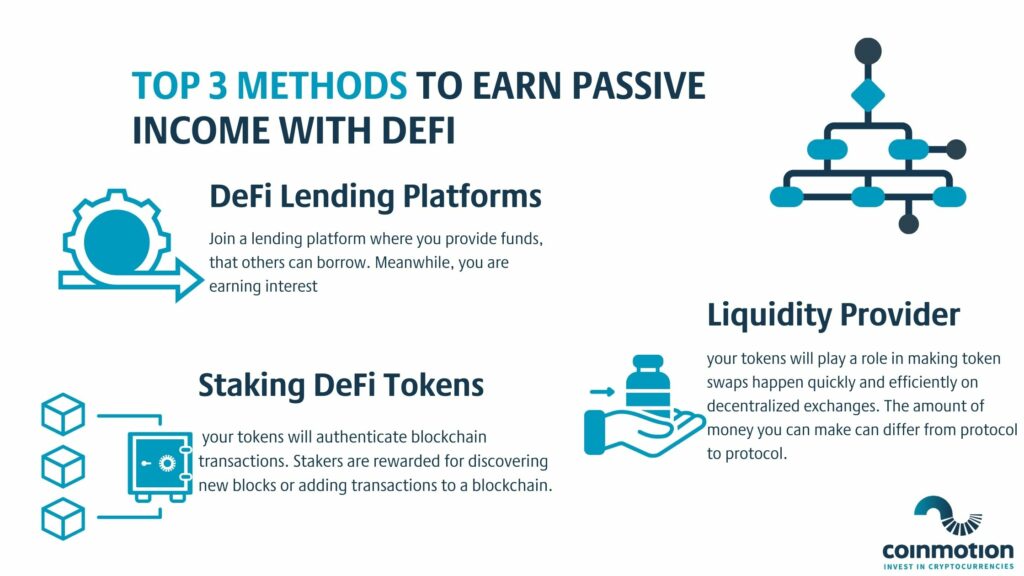For most people, passive income is only a dream. At the same time, a few amongst us have managed to turn their side-hustles into hands-free cash cows. The vast majority of people thinking about income mostly spend their time thinking, making plans, and Googling; in this article, we will explain the top 3 methods to earn passive income with DeFi.
But in 2021, decentralized finance (DeFi) is turning the dream of passive income into a reality. The principle behind DeFi is to take traditional financial services and make them totally autonomous. This removes the “middle man” and his paycheck. Instead of paying banks, payments companies, and other financial institutions for the services they offer. DeFi platforms collect fees and redistribute them to all of their participants.
In other words, contributing to a DeFi platform is a great way to make your money work for you. It’s not as simple as depositing your tokens, and watching your wallet get thicker participating in DeFi is never without risk. Here are some of the most common methods to earn passive income with DeFi and how you do it safely.

Staking DeFi Tokens
Staking is the process of “locking” your cryptocurrency into a protocol in exchange for token rewards–kind of like storing money in a bank in exchange for interest. When you stake, you become a transaction validator, or node, for the network. This is very important to the network’s functionality and security, which is why stakers are financially incentivized.
Most commonly, the coins you’ll be staking on a blockchain protocol are the blockchain’s native token (ETH for Ethereum.). Depending on which tokens you’re staking, you can earn more significant rewards for keeping them locked up for more extended periods or staking larger amounts of cryptocurrency. In most cases, stakers can withdraw their cryptocurrencies at any time. However, some blockchain networks discourage withdrawals by charging exit fees.
The amount of rewards you’ll earn also depends on the kind of tokens you’re staking: some people earn as much as 23% plus APY (annual percentage yield) for staking the Binance Coin. Coins such as Algorand (ALGO), Kava (KAVA), Texas (XTZ), and Tron (TRX) can earn stakers up to 12% APY.
Staking can be a tricky process that requires quite a bit of technical know-how. If you’d like to start staking, but you’re not sure how to do it, consider lending your coins to a trustworthy staking-as-a-service platform. These platforms take care of the heavy lifting for you in exchange for a portion of your earnings.
DeFi Lending Platforms
Similar to staking, you can earn passive income from DeFi lending platforms by locking up your tokens for long periods. However, unlike staking, which uses token deposits as part of the transaction validation process. Crypto lending platforms put tokens to work another way.
When you deposit cryptocurrency into a lending platform, the platform will lend it out to other users and provide you with an APY in exchange. For example, Compound Finance, for instance, offers APYs as high as 7.5%. In some cases, these APYs can be more than 20 percent.
DeFi lending platforms are also designed in such a way that the risk of default is very low. DeFi loans are famously over-collateralized, with collateral requirements as high as 200% of the borrowed amount. People who deposit their crypto in DeFi lending platforms can withdraw it whenever they wish, usually without incurring an exit fee.
However, there are several risks to this type of passive income. For example, flash loan attacks, in which bad actors borrow huge sums of money and use it to exploit vulnerable DeFi protocols, can result in the loss of funds. However, many of the protocols that have experienced flash loan attacks have quickly restored users’ funds.
Become a Liquidity Provider: Earn Passive Income with DeFi
Becoming a Liquidity Provider (LP) is yet another way to earn passive income in exchange for locking up your tokens. Only this time, your coins won’t be used to confirm transactions or provide crypto loans. Instead, your crypto will play a role in making token swaps happen quickly and efficiently on decentralized exchanges or DEXs.
Indeed, DEXs like SushiSwap, Yearn. Finance, Uniswap, and others have become popular because of automated market maker (AMM) algorithms that offer fast and efficient trading services. Traditional order book models match buyers and sellers–a process that can sometimes take long periods, particularly when dealing with large trades. AMMs, by contrast, automatically fill trading orders with liquidity from LPs.
The amount of money you can make as an LP can differ from protocol to protocol; LP aggregators pull real-time data that can help you project potential returns on different platforms.
But some LPs don’t make any profit at all; it’s also possible for LPs to lose money through a process called impermanent loss (IL), which takes place in particularly volatile market environments. While it’s not possible to remove the risk of IL, one can mitigate it by choosing highly-liquid pools of relatively less volatile assets.
In conclusion
There are too many ways to earn passive income in the DeFi universe–make sure you choose the right one for you. Before making purchases or deposits of any kind, ensure that the platforms you’re working with are trustworthy. Never invest more than you can afford to lose.
This web page’s material is not investment advice and does not represent an offer or solicitation to offer or recommend any investment product. It is intended for general use only and does not consider your unique needs, investment objectives, or financial situation.
